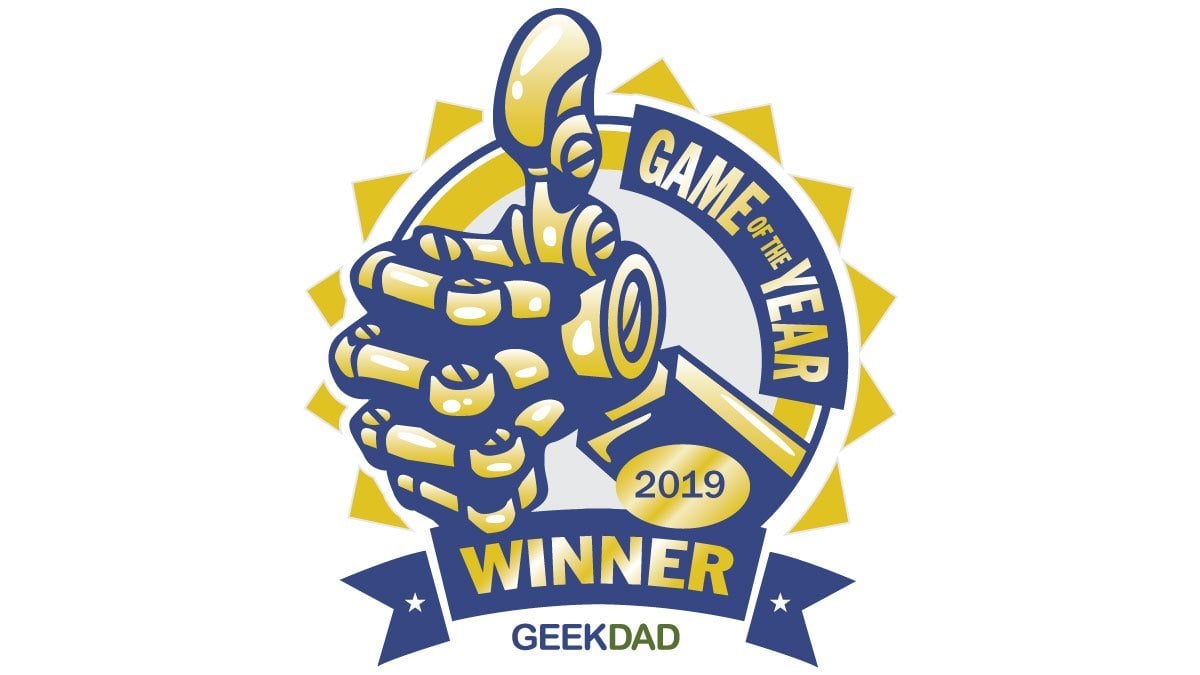
 Overview: Switch, swap and flip cards to get at least four of a kind in a row — but your cards are double-sided and your opponents can use them too! FlipOut is a fast, easy-to-learn game from Gamewright. The strategy is lighter but the game can be quite addictive.
Overview: Switch, swap and flip cards to get at least four of a kind in a row — but your cards are double-sided and your opponents can use them too! FlipOut is a fast, easy-to-learn game from Gamewright. The strategy is lighter but the game can be quite addictive.
Players: 2 to 5
Ages: 8 and up
Playing Time: 15 minutes
Retail: $19.99
Rating: Worth flipping out for.
Who Will Like It? I’d recommend FlipOut to families looking for a game that works for a wide range of ages, but don’t discount it even if your gaming group is mostly hardcore heavy-strategy fans. I played this one with the same gamers who like Power Grid and Thunderstone, and we couldn’t get enough of it.
Components:
The game comes with 90 double-sided cards and 5 card holders. The cards are brightly-colored with fun patterns on them and they’re pretty stiff and glossy. That makes them a bit hard to shuffle but it ensure that you can’t see through the cards, which is very important in the game. Each card has one of the five colors on each side — the front and back could match or they could be different. The card holders are sturdy plastic and come in two pieces that notch together, and each holds six cards upright in a slight curve.
Since that’s all that comes in the box, it does mean there’s a lot of empty space around the plastic divider, but it would’ve been hard to make it all fit neatly into a smaller container, so I guess I’ll give Gamewright a pass on this one.


On my turn I'll swap for a yellow and score four — if the cards are still there. Photo: Jonathan Liu
Gameplay:
The rules are quite simple and can be explained in a few minutes so you can get to playing right away. The goal of the game is to accumulate the most cards by collecting sets of 4, 5 or 6 adjacent cards of the same color. The game ends when you run out of cards, and whoever has the biggest stack of cards wins.
On each turn, you get two actions from the following list:
- Flip: Turn a card around in its holder (yours or another player’s) so that the front and back are reversed.
- Switch: Switch the positions of two cards in your or another player’s holders.
- Swap: Trade one of your cards for one from an opponent, always keeping the same side of each card facing you.
- Swap 2: Trade two adjacent, same-color cards from your holder with two adjacent, same-color cards in an opponent’s holder. (For example, two blues on my holder with two purples on an opponent’s.)
- Score: Collect a set of 4, 5 or 6 adjacent same-color cards from your holder. Show everyone your set, set it in your pile and refill your card holder.
- Swipe: Collect a set of cards from an opponent’s holder — but you must give them one of the cards and keep the rest for yourself.
That’s it!
For a two-player game, there’s an additional action: draw the top card from the center deck and swap it with one of yours, which goes back to the bottom of the deck.
Conclusion:
I love games with unique mechanics, and FlipOut is certainly unlike other card games I’ve played. It can be pretty fascinating (and sometimes frustrating) not knowing what’s on the backs of your cards. Yes, you get a chance to see them when you draw the cards, but once you’ve placed it in your holder you don’t get to peek at them again unless you use a Flip action. One of my fellow players was better at keeping them memorized but that only worked for the cards he drew himself — if a player swaps out a card, then he’s never seen the other side of it. Another interesting aspect is when you swap cards with an opponent: to you and your opponent, the cards swapped don’t change colors; but to a third player any cards swapped will be flipped inside out.
While I haven’t yet played Cabo myself, the same idea of not knowing everything about your own cards carries over — however, in this case there’s less room for building up strategy. As with a game like Fluxx, you can’t expect that the playing field is going to look the same by the time it’s your turn again. Your cards will likely have been moved around, traded with other players or even completely swiped and replaced. In most of the games we played, almost every turn had somebody scoring at least four because you want to grab that opportunity while you can. It generally won’t work to take two turns to get to a set of six. That can make it feel a bit chaotic, but it is also tremendously fun. I brought it out as a filler after a game of Power Grid and we ended up playing several times in a row, and then playing again in between other games. It goes quickly and it’s easy to play a couple rounds in one sitting.
I’ve generally been impressed with Gamewright’s selections, which are always family-friendly. Some of their games are best for younger players, but FlipOut is one that works well with older players as well, so I wouldn’t hesitate to recommend it for your collection.
Wired: Simple rules lead to complexity in play; extremely fun and addictive.
Tired: Big box for a compact game; cards can be tough to shuffle.
Disclosure: GeekDad received a review copy of this game.




